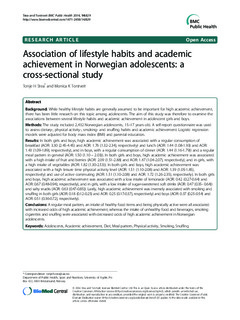| dc.description.abstract | Background: While healthy lifestyle habits are generally assumed to be important for high academic achievement,
there has been little research on this topic among adolescents. The aim of this study was therefore to examine the
associations between several lifestyle habits and academic achievement in adolescent girls and boys.
Methods: The study included 2,432 Norwegian adolescents, 15–17 years old. A self-report questionnaire was used
to assess dietary-, physical activity-, smoking- and snuffing habits and academic achievement. Logistic regression
models were adjusted for body mass index (BMI) and parental education.
Results: In both girls and boys, high academic achievement was associated with a regular consumption of
breakfast (AOR: 3.30 (2.45-4.45) and AOR: 1.76 (1.32-2.34), respectively) and lunch (AOR: 1.44 (1.08-1.93) and AOR:
1.43 (1.09-1.89), respectively), and in boys, with a regular consumption of dinner (AOR: 1.44 (1.16-1.79)) and a regular
meal pattern in general (AOR: 1.50 (1.10 – 2.03)). In both girls and boys, high academic achievement was associated
with a high intake of fruit and berries (AOR: 2.09 (1.51-2.88) and AOR: 1.47 (1.04-2.07), respectively), and in girls, with
a high intake of vegetables (AOR: 1.82 (1.30-2.53)). In both girls and boys, high academic achievement was
associated with a high leisure time physical activity level (AOR: 1.51 (1.10-2.08) and AOR: 1.39 (1.05-1.85),
respectively) and use of active commuting (AOR: 1.51 (1.10-2.08) and AOR: 1.72 (1.26-2.35), respectively). In both girls
and boys, high academic achievement was associated with a low intake of lemonade (AOR: 0.42 (0.27-0.64) and
AOR: 0.67 (0.48-0.94), respectively), and in girls, with a low intake of sugar-sweetened soft drinks (AOR: 0.47 (0.35- 0.64))
and salty snacks (AOR: 0.63 (0.47-0.85)). Lastly, high academic achievement was inversely associated with smoking and
snuffing in both girls (AOR: 0.18 (0.12-0.25) and AOR: 0.25 (0.17-0.37), respectively) and boys (AOR: 0.37 (0.25-0.54) and
AOR: 0.51 (0.36-0.72), respectively).
Conclusions: A regular meal pattern, an intake of healthy food items and being physically active were all associated
with increased odds of high academic achievement, whereas the intake of unhealthy food and beverages, smoking
cigarettes and snuffing were associated with decreased odds of high academic achievement in Norwegian adolescents. | nb_NO |

